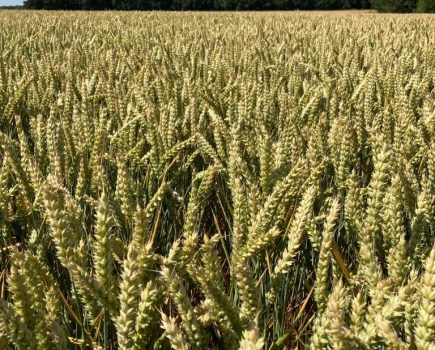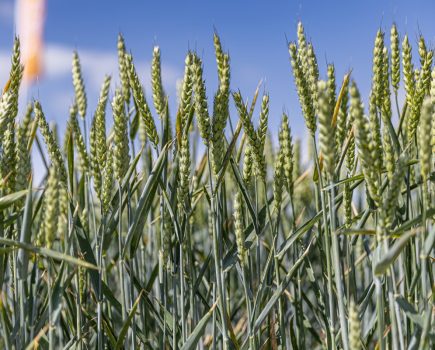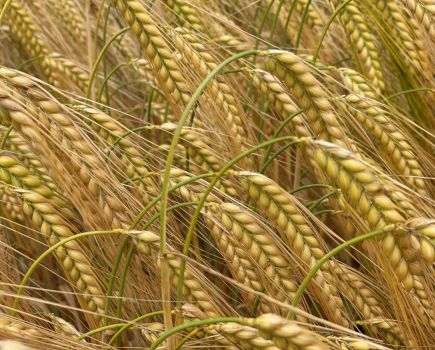Plant breeding has been at the forefront of progression on arable farms since time began. However, new technology could help to accelerate this and bring forward varieties which solve some of the biggest grower and consumer challenges. CPM finds out more.
“What we’re trying to achieve isn’t creating something entirely new, we’re simply enhancing existing varieties with remarkable precision” – Professor Cristóbal Uauy.
By Charlotte Cunningham
Agriculture stands at a critical juncture – with global population projected to reach 9.7Bn by 2050, the demand for food will increase by an estimated 70%. All the while, climate change threatens traditional farming methods, causing more frequent extreme weather events, reducing crop yields and threatening food security. Arguably, this unprecedented challenge requires revolutionary solutions and precision breeding is emerging from the shadows as a potential game-changer…
To understand precision breeding’s significance in modern agriculture, it’s important to first recognise the historical journey of agricultural innovation. This is because plant breeding isn’t a modern invention, but a practice as old as human civilisation itself. From the moment farming ancestors first selected and replanted seeds with desirable characteristics, the complex process of genetic manipulation began.
THE FOUNDATION
Over many generations and during the past century, there have been many key moments which have accelerated – and ultimately led to the development of – precision breeding. This includes early 20th century work by Austrian biologist Gregor Mendel on genetic inheritance, which – despite being initially overlooked – became the foundation for modern plant breeding.
His experiments with pea plants conducted in the mid-19th century revealed fundamental principles of genetic inheritance that revolutionised agricultural science.
In more recent history, the development of hybrid corn in the 1930s demonstrated how systematic genetic selection could dramatically increase crop productivity. Researchers like Henry Wallace in the US discovered that cross-breeding specific corn varieties could produce offspring with significantly higher yields – a phenomenon now familiarly known among breeders and farmers as hybrid vigour.
Precision breeding, therefore, represents the next evolutionary step in this centuries-long journey. But to truly appreciate its significance, it’s important to delve into the intricate scientific mechanisms which make it possible – something which was explored in detail during a recent webinar hosted by the British On-Farm Innovation Network (BOFIN) as part of the PROBITY (Platform to Rate Organisms Bred for Improved Traits and Yield) project.
Led by BOFIN, PROBITY is a three-year £2.2M multi-partner project funded by Defra’s Farming Innovation Programme. The aim is to set up a new farmer-led platform to multiply precision-bred organisms (PBOs) in farmers’ fields to provide enough material for batch processing.
Looking at this in more detail, the platform is putting in place the infrastructure and process required to take a PBO from less than 1kg of seed to a 100t batch in just three years. Crops will be tested by farmers alongside unedited controls and their farm standard varieties.
Progress in the field will be closely monitored, processed material intensely scrutinised, on-farm practices assessed, and findings will be openly shared. The goal is to explore how farmers feel about growing PBOs and consumers’ thoughts about having food made with them.
Professor Cristóbal Uauy, director designate of the John Innes Centre, is one of the project partners and led the conversation, delving into how scientists use precision breeding techniques such as gene editing to develop innovative crop traits, and the potential benefits this could bring sustainable food and farming.
“A lot of the work we do is trying to understand how plants perform in the field – addressing why we might have yield gaps, for example. But at the same time, we’re trying to understand the genetic sequences behind these improvements, and often this comes down to changes in DNA or mutations.”
His analogy of wheat DNA as a 3.1M page book for a single variety provides a compelling visualisation. “Imagine a text so vast that if printed, it would create a stack of papers taller than London’s most prominent landmarks. Within these millions of pages lie the secrets to crop improvement – but it requires a huge amount of work to identify this.”
THE REVOLUTION
However, thanks to what Cristóbal described as the ‘genome revolution’, it’s now possible to sequence these genomes, and his work has found that a lot of the changes seen in the field results from tiny differences. “Essentially, all the variation we see in the Recommended List comes down to these small changes in DNA.”
Accessing these changes is now being made easier with the gradual introduction of genome editing techniques like CRISPR, which act as molecular scissors capable of making precise changes at specific genetic locations, he explained. “Unlike traditional genetic modification which often involves inserting entire genes from different organisms, precision breeding makes targeted modifications which would happen naturally overtime – albeit incredibly slowly.”
To provide context, Cristóbal said a single wheat plant contains approximately 100 natural mutations in each generation, but with traditional breeding techniques it takes around 10-15 years to develop a new variety. This is far too slow to address some of agriculture’s rapidly evolving challenges, he said.
“What we’re trying to achieve isn’t creating something entirely new, we’re simply enhancing existing varieties with remarkable precision. In fact, mutations that are generated by genome editing are indistinguishable from those which occur naturally – hence why there is so much excitement about it,” highlighted Cristóbal.
In terms of legislation, anyone au fait with the plant breeding world likely knows it’s a highly regulated sector. However, the UK has positioned itself at the forefront of precision breeding regulation with the Genetic Technology (Precision Breeding) Act 2023, which represents a nuanced approach by providing a scientific, streamlined pathway for approving precision-bred crops while maintaining rigorous safety standards.
This legislation is unique in Europe, making England the only place on the continent where such crops can be commercially grown. This is a significant opportunity which could position British agriculture at the cutting edge of global food production, explained Professor Nigel Halford from Rothamsted Research. “Two years ago, the government introduced a change to what was under genetically modified regulations which has allowed us to undertake field trials with genome-edited crops much more simply than before – with a simple notification to Defra.
“That was followed by the ‘PBO Act’ last year, which introduced the term precision bred organism. This is a genome-edited plant which has no GM element to it. There will be two categories of PBO – one for research only and a second category for marketing. Because we don’t know exactly how that’s going to work yet, we have secondary legislation which was passed in March and seems to be going ahead.”
If all goes according to plan, this will allow genome-edited varieties to enter the marketplace, noted Nigel. And the introduction of these varieties could solve some major challenges for both farmers and consumers, with Nigel’s low-acrylamide wheat research exemplifying precision breeding’s potential.
“Acrylamide isn’t present in wheat grains, or any other crops, but it forms during normal cooking and processing including baking, frying and toasting. It’s a highly undesirable chemical to have in your food; it’s probably carcinogenic, it’s neurotoxic and it affects fertility.
“Of course, it’s present in parts per billion levels, but some foods have several 100 parts per billion. Now, we already have regulations on the presence of acrylamide in food that rolled over from the EU at Brexit. So we have benchmark levels which food businesses have to work towards.
“This year it’s expected that the EU will set maximum levels which make it illegal to sell a food product if it’s above that threshold. So that’s a juggernaut coming down the road for the European food industry, and it’ll affect the UK supply chain too.”
In small scale field trials using genome editing, Nigel explained that researchers have been able to reduce concentrations by up to 90%. “This demonstrates how the technology can simultaneously address agricultural productivity and food safety concerns going forward.”
With the technology available and the legislation seemingly in place, all that remains is to get the farming community on board. With some growers scarred from the industry’s attempt at dabbling with genetic modification in the past, new technologies such as gene editing are often perceived as highly emotive – which could be due to confusion with what the process actually involves.
POTENTIAL
However, Yorkshire farmer Paul Temple says if done correctly, they offer a huge amount of potential to the industry. A mixed arable and beef farmer from East Yorkshire, Paul said the approach at Wold Farm is based around a combination of productivity and conservation.
“I was a classic ‘farmer sceptic’ many years ago, but my driver has always been the application of science. I was fortunate to be involved in field-scale evaluation trials from what I classified as a neutral, sceptical position, and I’ve learned a huge amount just watching what was happening in the fields with the guys who were running the trials.
“It made me appreciate breeding, probably for the first time, because I saw both the conventional techniques and a novel approach physically in the field.
“Alongside this, I learned a lot about how this topic is presented in the media and found it hugely frustrating that subjective, unfounded arguments were just laid into objective science.”
As a result, Paul became involved in the Global Farming Network which covers 70 countries and looks at how plant breeding is being applied worldwide. “What’s really fascinating is that precision breeding isn’t just about large-scale farming – it benefits even the smallest of growers by giving them access to the latest technology, regardless of their size.”
To facilitate better discussion between farmers and the wider industry, the PROBITY project has set up ‘The Sequence Circle’ – a community of farmers established to drive discussion and steer the project. Part of this is a moderated Knowledge Cluster – a discussion forum with resource hub – which launched last autumn and aims to build to at least 300 farmers, scientists, plant-breeding representatives and other industry innovators, who lead the conversation on precision-bred crops and trade knowledge on how to progress the technology.
“This technology isn’t about eliminating choice but rather providing farmers with more sophisticated tools to address complex agricultural challenges,” concludes Paul. “As we look to feed a growing global population in an era of unprecedented environmental change, challenges to yield and issues with finding molecular chemical solutions, precision breeding isn’t just a possibility – it’s becoming a necessity.”
This article was taken from the latest issue of CPM. Read the article in full here.
For more articles like this, subscribe here.
Sign up for Crop Production Magazine’s FREE e-newsletter here.




